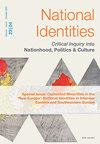“为国王和国家信仰和工作!”通过青年组织Straja Țării实现国有化和秘密罗马尼亚化(1934-1940)
IF 0.7
Q3 POLITICAL SCIENCE
引用次数: 0
摘要
摘要本研究调查了罗马尼亚国王卡罗尔二世在两次世界大战第二个十年创建的青年组织StrajaȚării。该研究将考虑两个层面的分析:StrajaȚării在国家统一项目中的组织和意识形态层面(1);犹太青年与StrajaȚării的关系(2)。虽然Straja包括7至18岁的青少年,但我将主要关注青少年(14岁以上),因为他们是激进政治运动的独特工具群体。该论文的主要论点是,StrajaȚării被包装在国家建设和加强的公式中,是一个相当无效的组织,它是巩固国王在内部和外部权力的工具。关于少数民族,Straja在鲁莽、同化和排斥之间摇摆不定,缺乏任何融合非罗马尼亚人的机制。本文章由计算机程序翻译,如有差异,请以英文原文为准。
‘Faith and work for King and Country!’ Nationalization and covert Romanianization through the youth organization Straja Țării (1934–1940)
ABSTRACT This study investigates the youth organization Straja Țării, created by King Carol II of Romania in the second interwar decade. The research will consider two levels of analyses: the organizational and ideological dimensions of Straja Țării within the national project of unification (1); the relation of the Jewish youth to Straja Țării (2). Although Straja included youngsters from ages 7 to 18, I will focus mainly on adolescents (above the age of 14), because they were a distinct instrumental group for radical political movements. The paper’s main argument is that by being packed in the formula of nation-building and strengthening, Straja Țării was rather an ineffective organization which served as a tool to consolidate the king’s power at both the internal and external level. In relation to ethnic minorities, Straja oscillated between recklessness, assimilation, and rejection, lacking any mechanism for integrating non-Romanians.
求助全文
通过发布文献求助,成功后即可免费获取论文全文。
去求助
来源期刊

NATIONAL IDENTITIES
POLITICAL SCIENCE-
CiteScore
1.70
自引率
0.00%
发文量
37
期刊介绍:
National Identities explores the formation and expression of national identity from antiquity to the present day. It examines the role in forging identity of cultural (language, architecture, music, gender, religion, the media, sport, encounters with "the other" etc.) and political (state forms, wars, boundaries) factors, by examining how these have been shaped and changed over time. The historical significance of "nation"in political and cultural terms is considered in relationship to other important and in some cases countervailing forms of identity such as religion, region, tribe or class. The focus is on identity, rather than on contingent political forms that may express it. The journal is not prescriptive or proscriptive in its approach.
 求助内容:
求助内容: 应助结果提醒方式:
应助结果提醒方式:


